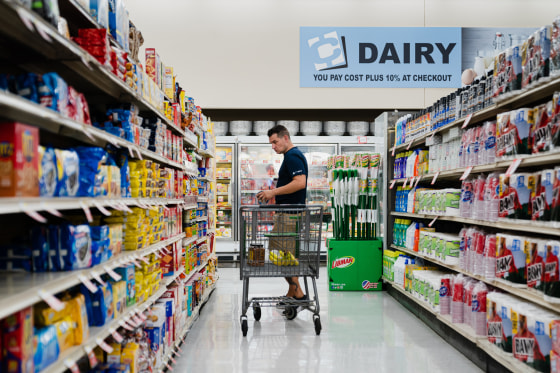An economic recovery under threat from the delta variant of the coronavirus got a shot in the arm this week from an unexpected source: food stamps.
Consumer sentiment, a leading economic indicator, plunged by 13.5 percent for early August as the delta variant rose, according to a recent University of Michigan survey, a drop exceeded only during the shutdowns in April 2020 and the depths of the Great Recession.
Anti-hunger advocates say the increases in the $79 billion Supplemental Nutrition Assistance Program, or SNAP, which went 15 years without an adjustment, are not just vital for the millions of Americans who face food insecurity from the pandemic; they are also a good investment.
Every dollar spent on SNAP benefits generates $1.67 in economic activity, according to calculations by Mark Zandi, chief economist at Moody's Analytics.
That's greater than the $1.31 per dollar for federal aid to state governments and the 32 cents per dollar for cutting corporate tax rates.
Wendy Edelberg, a senior economics fellow at the Brookings Institution, where she is director of the Hamilton Project, an economic policy initiative, said: "People who receive SNAP benefits are generally living paycheck to paycheck. It increases their spending on nutritious food, and it helps them to be more financially secure broadly, so that's why we see that it boosts consumer spending."
The average benefit will increase by about 25 percent. That equates to about $36 a month on top of the existing average benefit of $121. The New York Times estimated that the SNAP program overall cost would go up by $20 billion.
The influx of money will be especially significant for small grocers and mom-and-pop retailers who have been battered by the pandemic and face the prospect of raising workers' pay to compete with larger rivals. Being able to afford groceries frees up other spending, and it tends to be spent in local neighborhoods, providing targeted economic stimulus to hard-hit communities.
"The entire grocery sector will benefit from this — everyone in the supply chain, starting with the farmers through the manufacturers and retailers," said Arun Sundaram, an equity analyst at CFRA Research.
The emergency provisions Congress passed last year to increase SNAP benefits by 15 percent are winding down. The increase will apply to all of the program's 42 million recipients — a figure that has risen because of the economic hardship the pandemic inflicted on many people, particularly lower-income families.
Technically, the SNAP increase, which does not need congressional approval, is an update of the Agriculture Department's Thrifty Food Plan, from which benefit amounts are derived. The Agriculture Department was directed to review the Thrifty Food Plan as part of the 2018 farm bill.
The Agriculture Department said its analysis found that the cost of a "nutritious, practical, cost effective diet" was more than 20 percent higher than the existing Thrifty Food Plan estimate. "The resulting cost adjustment is the first time the purchasing power of the plan has changed since it was first introduced in 1975," the agency said Monday.
Although the 2018 farm bill passed with bipartisan support, as did an increase of SNAP benefits during the pandemic, the program has been a target of GOP deficit hawks who want to pare, rather than expand, entitlement safety net programs.
As early as May 2020, when lockdowns were still in place in much of the country and the unemployment rate was at a staggering 13.3 percent, lawmakers like Rep. Mike Conaway, R-Texas, objected to expanding the program. "I don't want to create a moral hazard for people to be on welfare," Conaway told The New York Times.
People who run food banks say the increase to SNAP benefits in October will come just in time for many of their clients. Food pantries had an overwhelming surge in demand at the onset of the pandemic; since then, the initial financial shock that struck many households has been somewhat mitigated by stimulus payments and expanded unemployment benefits, but those backstops are being dismantled.
"When you give someone access to SNAP, that extra money that they may have goes to paying a bill or goes to buying their kid a pair of shoes — it goes directly into the economy," said Juanita Burden, director of benefits and customer outreach at the Mid-Ohio Food Collective, who said about 30 percent of the organization's clients are new since the onset of Covid-19. "During those first months ... it was kind of overwhelming to see how much people needed," she said.
One of the goals of the Agriculture Department's evaluation was to give an increasingly diverse populace greater access to foods that reflect how — and what — they cook.
Dzigbordi Egbenya lives in the Maryland suburbs of Washington, D.C., and volunteers with a community advocacy group raising awareness about food insecurity. Egbenya, 61, said the increase in her SNAP benefits will make it easier to buy ingredients to cook traditional African dishes like akple (dumplings typically made from corn and cassava) and okra soup.
"That is predominantly what we eat in the area I'm coming from, and I can afford that with the 25 percent increase, and that is wonderful," she said.
